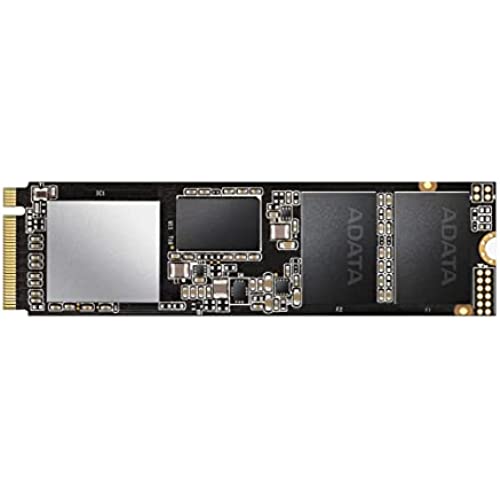
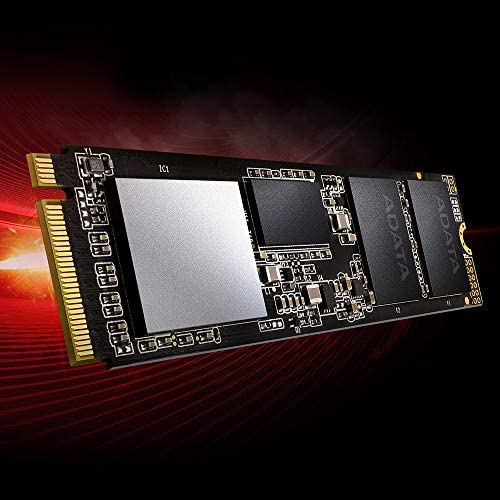
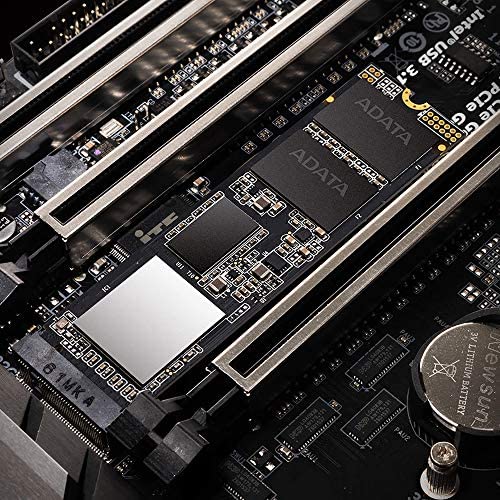
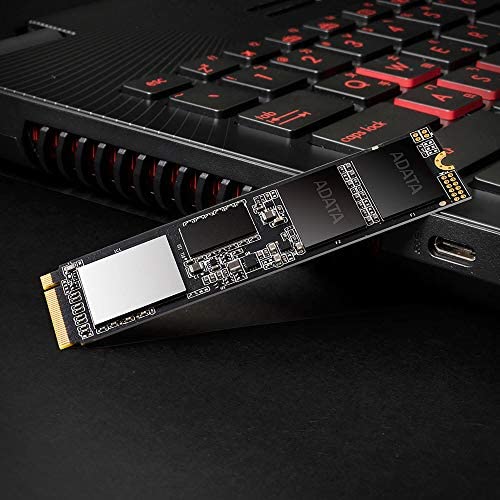
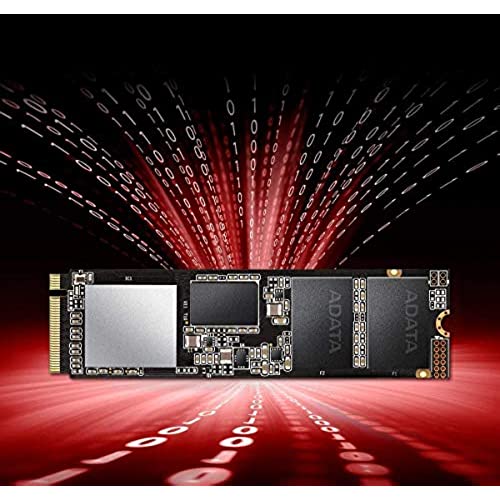
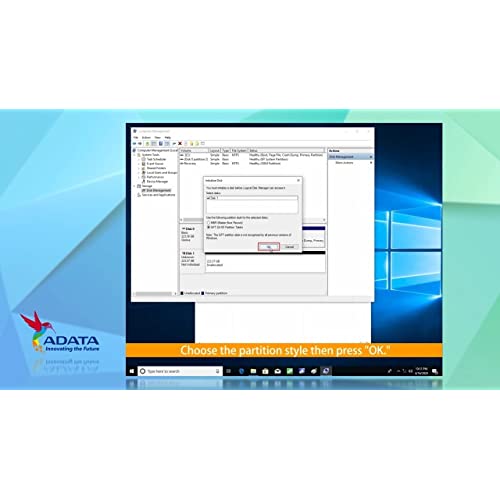






XPG SX8200 Pro 2TB 3D NAND NVMe Gen3x4 PCIe M.2 2280 Solid State Drive R/W 3500/3000MB/s SSD
-

Bob in CLE
Greater than one weekI bought this to upgrade an HP EliteDesk 800 G2 small form factor desktop, with an I7 6700. Obviously, not a gaming machine. I wanted something a little larger and a little faster than the 256 gig SSD it came with. Im very happy with my purchase. Ive bought dozens of Adata drives and never had a problem. My motherboard does not have an NVME slot. So, I bought the $8 adapter in the pic. amazon.com/gp/product/B07VYWR91T/ref=ppx_yo_dt_b_asin_title_o00_s02?ie=UTF8&psc=1 The adapter board was shipped, attached to the larger of the two brackets it was supplied with. I removed the bracket, installed the new drive, then attached the board to the low profile bracket. When I installed the board and powered up, bios and Windows 10 recognized the new drive immediately. I cloned the SSD to the new drive using the free version of Aomei Backupper. I find it less troublesome than other software. Afterward, powered down, removed the old drive and was up and running. All of this in a matter of minutes. I ran Crystal Disk Mark and the pic shows the results. Not bad. Im running the cpu, with turbo boost disabled, because it runs too hot when using video editing software. To see if read and write scores would improve, I enabled turbo boost. I got slightly lower scores. I dont know why. I dont really care either. Im happy.
-

Myroslav
> 3 dayPurchased 2Tb size on June 20 2021 for ~230$ (prime day) and received ENG version (fast). Testing on laptop showed 1700Mb read and 3000 Mb write which was even lower than my laptop OEM 1Tb SSD (3000 read/write). Even cloned OEM ssd and inserted this adata ssd into main nvme/slot just to see if slot can be faster. Same speed, no difference. Also, when copy 25gb file to drive after ~10gb there is drop in speed from 1500 to 800 Mb which jumps back to 1500 in few seconds (cache was full). I knew about Adata shame replacement of components to cheaper but this one is ENG version and should be fast. Also got same drive from BestBuy (also ENG and got same speed). Unit shows 92 layers of TLC memory from Samsung by flash info app. Finally, found WD Black SN750 2Tb version on eBay and won 208$ auction for new sealed. Installed to laptop, tested and received 3000 read and write. In game mode (setting in WD Dashboard) WD sdd was showing even 3200 mb read which was close to 3450 Mb advertised. Also, copying same 25Gb file and even 5 of these files with over 180Gb size did not show any drops and was close to 1.7Gb most of the time. This is a shame for Adata to show 3500 read and 3000 Mb write on box as this is not true. It was like 1-2 years ago,, I believe but not with latest versions which you get from any store. Returning item. If you want drive with 2000 mb read but 3000 Mb write (if you process files, etc) then you can purchase Adata 8200Pro but do not expect 3500 read. At least, it was my experience with laptop and, maybe, using powerful desktop you can get higher speeds. Not for me and WD Black SN7500 2Tb was twice faster on read speeds and same write speed on my 1700$ laptop. Thank you
-

bummster
> 3 dayThe 1TB model is the right blend of cheap, fast, and good. Its got some interesting characteristics that you need to keep in mind though. The nand controller in here, is an SMI SM2262EN and its been setup in a way that people may not expect. Namely, when you sequential write to the drive itll go full blast for about 15-20% of whatever free space you have on the drive. Empty 1TB drive = ~3500Mbps until about 150GB. Then youll see your speed get cut anywhere from 50-80% while the nand controller adjusts its strategies for writing data. This write strategy should be invisible to most people. But, you really dont want to fill up this drive. Which is probably the exact opposite thing you want to do with storage. :) I suspect many people bought smaller capacity version of this, and have inadvertently hamstrung themselves. When buying SSDs with this specific controller, you want to buy the biggest capacity one you can afford or make sure that the system it is installed in doesnt do big data moves. Having said that, even at its slowest max sequential write, its still faster than a SATA SSD. If youre the type of person that leaves all your data on a NAS or external storage and just need a super fast boot drive, this thing is fantastic for the price. The reigning king of the cheap low tier NVME drives, especially when the 1TB model hits a lightning deal. If youre going to load up the drive and leave it at like 75% full all the time, youll probably want to look elsewhere. The SLC Cache strategy is going to bug the heck out of you and probably wont pass muster on SSD benchmarks in that state.
-

Kinomora
> 3 dayUpgraded from a pretty cheap SSD which wasnt super fast or large. This M.2 SSD runs the NVMe protocol over PCIe 3.0 at x4 lanes. This is not a SATA M.2 drive. Not all motherboards provide M.2 NVMe SSD slots, make sure yours is compatible! Additionally, if you plan to install Windows (or any other OS for that matter) on this drive, check the manufacturers webpage or manual to validate whether or not it is capable of booting to an NVMe SSD in the first place. I installed this drive into my Biostar GT5 X370 Racing motherboard for AM4 with a Ryzen 2600. When loading into Windows still installed on my old drive, it was fine- detected right off the bat (you may need to open Disk Manager and initialize the disk before it shows in Explorer) and the speed at which it accepted and loaded files was amazing. My trouble came when trying to install Windows to it. At first I thought it would be a simple clone job, moving from one SSD to another- turns out, there are some BIOS settings that need to be changed. I spent nearly 3 days working through tutorials and guides trying to get this working, and Im not sure what combination of them caused it to finally work, but what seems to finally make it successful was disabling secure boot and disabling CSM in the bios, then inserting a windows installation USB drive, deleting the partition on the drive and formatting it, and finally allowing the installer to create the required 4 partitions for GMT. I now have Windows successfully installed on the drive and its amazing, really, if you dont have an SSD in your system youre missing it. I press the power button and as soon as the bios screen fades the desktop is already there. Applications load almost instantly, installations are lightning fast, this drive rivals the top of the line Samsung Evo and Pro SSDs in terms of speed, at half the cost. In highly recommend this to anyone looking to increase the performance of their system without breaking the bank.
-

KUMS
> 3 dayHere is the peak performance I could get with 10g file size and different block sizes. Ran on Ubuntu OS and at block level with direct IO (to avoid any filesystem caching effect). I suggest, disable filesystem cache (or do direct IO) with the benchmarking tool you are using to find the real performance. If I increase the QDEPTH, latency shoots up crazy particularly for block sizes 64k and above. With small files (5g and less) write performance is lot better for block sizes 64k and above. Here are the ball park numbers you can expect (picked best possible number with QDEPTH which showed reasonable latency). 10g file size sequential /random read for different block sizes (MB/s) ===================================================== 4k - 1344 / 882 8k - 2485 / 1246 64k - 3121 / 1815 128k - 3124 / 2014 1m - 3125 / 2586 10g file size sequential / random write for different block sizes (MB/s) ====================================================== 4k - 645 / 466 8k - 782 / 477 64k - 790 / 478 128k - 864 / 476 1m - 825 / 473 - Sustained seq write with 1m block size is about 250 MB/s
-

Nathan
> 3 dayThe first one I got was DOA. Would not show up up all no matter how I mounted the drive. Amazon came to the rescue with a replacement that worked completely fine.
-

Brian
> 3 dayIts so good, Im buying another. Ive been using one for a couple years, and Ive had no problems whatsoever. Its getting a little full, and I saw that the price has gone down tremendously on these, so it was a no-brainer to buy another one. Im still on a Gen 3 motherboard, but it has been perfectly fast for my needs, and this drive is an awesome bang for your buck.
-

juanejot
> 3 dayI ordered this drive again two years after the first time, because my storage needs on the same PCI Gen3-capable board had increased, and the price & more recent reviews on this remained competitive. I had heard in the intervening time that ADATA had switched from the SM2262EN to the SM2262G controller, potentially affecting performance; had then heard that after public backlash they had switched back to the EN (this later revision referred to as “ENG,” and functionally equivalent to “EN,” not to “G”). That said, I was unsure whether old G controllers were still in distribution channels, especially given logistics concerns over the past two years. Unfortunately, the product listing is not specific, and I didn’t think to reach out to customer service to ask the question, until after I had placed my order. The automated response said to expect a response from a person within a few days AFTER I was due to receive the part; uh oh. But luckily, I got a response by the next day after my query, assuring me the item they had coming out to me was the “EN(G)” variant, and even guiding me on how to check once I had the packaging open, likewise assuring me that if it were “G,” I could send it right back & receive the correct one in replacement. When it arrived, it was indeed the ENG variant, matching both items I had received from them in the past. This experience of getting the ENG unit may not match your own, so if concerned, I urge you to reach out BEFORE ordering! That said, the speed and temperature profile of the one I received seems comparable to the original units, and the original review (below) stands, except that it’s now only about 2/3 the price it was then; even better! — Original review from 1/2020 below: MUCH cheaper than roughly equivalent Samsung units, with little performance hit. Especially on OSes for which the NVMe driver is not optimized for raw speed (say, macOS testing with Blackmagic Disk Speed Test, as opposed to Windows testing with CrystalDiskMark), the difference is likely negligible for most workloads, for a whole lot of savings. I chose not to use the included, but flimsy heatsink sheet, in favor of the one that came with the motherboard. Using that, I’ve never topped 40°C in the slot directly below the CPU (even under loads that put the CPU up to 85°C with a good but not amazing air cooler, in a case/fan config that’s admittedly pretty good for cooling).
-

Star Lord
Greater than one weekSuper fast (as expected), great performance for 2 years, then suddenly it hit its end of life? Set itself to read-only, totally bricked. Suspiciously a week after my warranty period was up. Would not buy from ADATA again, while its a nice cheap option, go with a more trusted brand like Samsung or Western Digital for drives that may be storing important things.
-

Steve Robbins
> 3 dayThe hardware is near flawless. The software, however has fatal flaws. First of all the software works only with Windows. If youre running Ubuntu Linux like I do, I guess they dont want to do business with you. Then when its time to download Acronis True Image for your Windows 10 installation because you bought it with the SSD, you find their instructions are plenty wonky. They ask for a validation code that just doesnt come with the SSD, saying that its on the sticker adhered to the product. It is not. The only thing on that label or the box labels was model number and serial number of the product. The photo they supplied as a guide clearly showed three numbers on the product. I sent photos of their sticker and box, along with screenshots of their instructions and asked how I was supposed to get the validation number to download and install Acronis True Image. They sent me a canned response telling me how to register for their website (which I clearly had already done) and how to register the product (which the photos I sent them but they hadnt bothered to look at clearly showed I had already done. I tried a second time. Heres the photos. Im registered on the AData website. My SSD is registered. You ask for a validation code, give me the photo of a sticker completely unlike the one that came on my SSD, which has only two numbers: model number and serial number. Please tell me what to do. They send me the same canned response not addressing my issue. One last try. Repeated myself, and expressed dissatisfaction with their customer service, which seems not to provide human responses. I asked what a perfect product is worth if customer service is terrible, cant they actually respond to my questions and allow me somehow to download and register Acronis True Image? I received a slightly different canned response without comment, which now showed that the validation number could be the serial number for certain unidentified instances. They had also changed the requirement that the validation number have a different number of digits than the serial number. I tried it, and finally, after three weeks, succeeded in downloading Acronis and registering it. Thats when I discovered that I didnt get Acronis True Image at all, but a small subset of the Acronis True Image tools. Why am I not surprised. As much as I like the hardware, AData gets not one more penny from me. Service after the sale truly sucks. What I I had been depending on Acronis True Image to clone a hard drive? I elected to go with a fresh install and saved two weeks! I totally rebuilt my system from scratch in two weeks less than it took AData to get me the tools that wouldnt have worked with Linux anyway. The hardware is great. Buy Acronis True Image if you have Windows. You wont be getting it from AData. If youre a Linux user, they have nothing for you. I suggest either building from a fresh install, a good idea once in awhile anyway, or using Back In Time, a free software obtainable in the Ubuntu repository.
